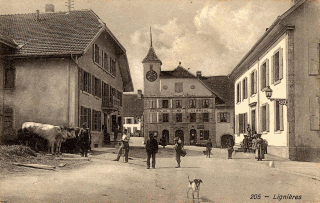
Lignières: Then and Now


|
Lignières: Then and Now |

|
 As part of the project to publish the first comprehensive
history of Lignières (Fourmilab's
home village) in
two centuries, two residents of the village who
are assiduous collectors of post cards, MM.
Louis Chiffelle
and
Werner Löffel
kindly consented to having their collections, totalling about 350
images in all, scanned for inclusion in the
archives of the
Fondation de
l'Hôtel de Commune de Lignières
As part of the project to publish the first comprehensive
history of Lignières (Fourmilab's
home village) in
two centuries, two residents of the village who
are assiduous collectors of post cards, MM.
Louis Chiffelle
and
Werner Löffel
kindly consented to having their collections, totalling about 350
images in all, scanned for inclusion in the
archives of the
Fondation de
l'Hôtel de Commune de Lignières
One of the great things about living in a place with a long and rich history (the ruins of a Roman villa have been excavated near the village, and the name of the village appears in a “Papal Bull” dated 1179, which I enclose in scare quotes because, in the 19th century, it was found to have to been forged, complete with a bogus signature and seal of Pope Alexander III, sometime around the date it bears) is that you see history around you every day. Although much of the central part of the village was destroyed in the fire of September 29th, 1832, structures which escaped and most of those erected since are recognisably the same as when built.
In the 19th and early 20th centuries, Lignières was a popular destination for summer vacations, with a number of hotels and pensions for holiday makers, which explains in part why so many post cards depict a village with only about 700 permanent residents at the epoch. With such a large collection of old-time photos (most dating from 1899–1920, but a few more recent) available on-line, I thought it would be interesting to show the continuity with the past and the changes of a century by putting together a gallery of images from the post cards juxtaposed with contemporary photos taken from the same vantage points as the originals.
As is frequently the case with my projects, I grossly underestimated the
complexity of this task and the amount of work it would entail. (But, hey,
if I didn't consistently do that, I'd probably not undertake many of
those projects. As Dennis the Menace observed, “You can't tell how
deep a puddle is from the top.”) To encourage folks contemplating a
similar project, I've written a tutorial on the
craft of “then and now” photography
which explains the techniques and tricks I've learned in the course of
this undertaking. I am entirely self-taught in photography and image
processing, so there may be better ways to go about things than those
I've discovered so far; that's what the “Feedback” button is for.
You can explore this transtemporal view of a small Swiss village either by taking our walking tour of several paths through the village, or explore on your own from the bird's eye perspective of the graphical index which allows you to click on viewpoints to see the village, then and now, from each. I have added comments to many of the pages to describe the location and history of the buildings in the picture. The abbreviation “RACN” indicates a structure's identification number in the 2006 edition of the Recensement architectural du canton de Neuchâtel published by the Office de la protection des monuments et des sites (OPMS) of the Canton of Neuchâtel, copyright © 2006 by the OPMS. With permission, all of the pages describing Lignières are included in PDF form on the DVD-ROM which accompanies the history book described above, and images of pages for structures which appear in this document are linked to their identification numbers.
|
by John Walker May, 2007 |
|